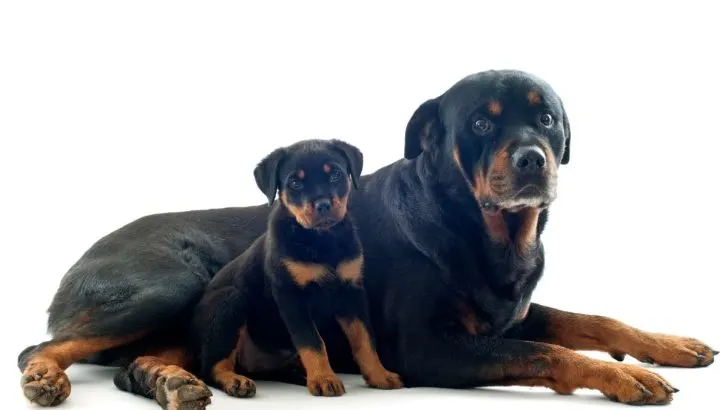Looking to buy a Rott puppy? One of a few things you maybe didn’t think you’d need to consider is picking the right Rottweiler color for you.
Rottweilers are not the most colorful dogs out there. Most people know these large dogs by their calm demeanor, protective temperament, black and brown coats, and big, muscular bodies.
However, there are more colors in the Rottweiler breed than you might’ve initially thought about.
Here are a few Rottweiler colors that are accepted as a norm and a few others you might run into:
Rottweiler Color Overview
| Recognized | Standard | |
| Black | NO | NO |
| Black and mahogany | YES | YES |
| Black and tan | YES | YES |
| Black and rust | YES | YES |
| Red | NO | NO |
| Blue | NO | NO |
| White | NO | NO |
Standard Coat Colors
Dog breed’s appearance and temperament are both a part of the breed standard, which is set by major kennel clubs in your area. For example, if you live in the United States, the main kennel club is the American Kennel Club (AKC).
Other major kennel clubs are the United Kennel Club (UKC) which is the main club in the UK, as well as the Federation Cynologique Internationale (FCI), which is the leading name in most of Europe.
Among other things, AKC regulates the colors in which each dog breed comes in.
There are a few reasons why some colors are considered standard while others are not.
Some colors are simply not found in a breed’s genetics. Not every breed has the same genes, and the appearance of some colors in certain dogs can indicate they are crossbreeds.
Another reason is that certain coat colors might be associated with some health conditions or faulty genetics. Some colors are almost always a sign of health issues, while others depend on the breed.
AKC recognizes 3 Rottweiler colors, and all are considered a part of the breed standard. Here’s what they are:
1. Black And Mahogany Rottweiler
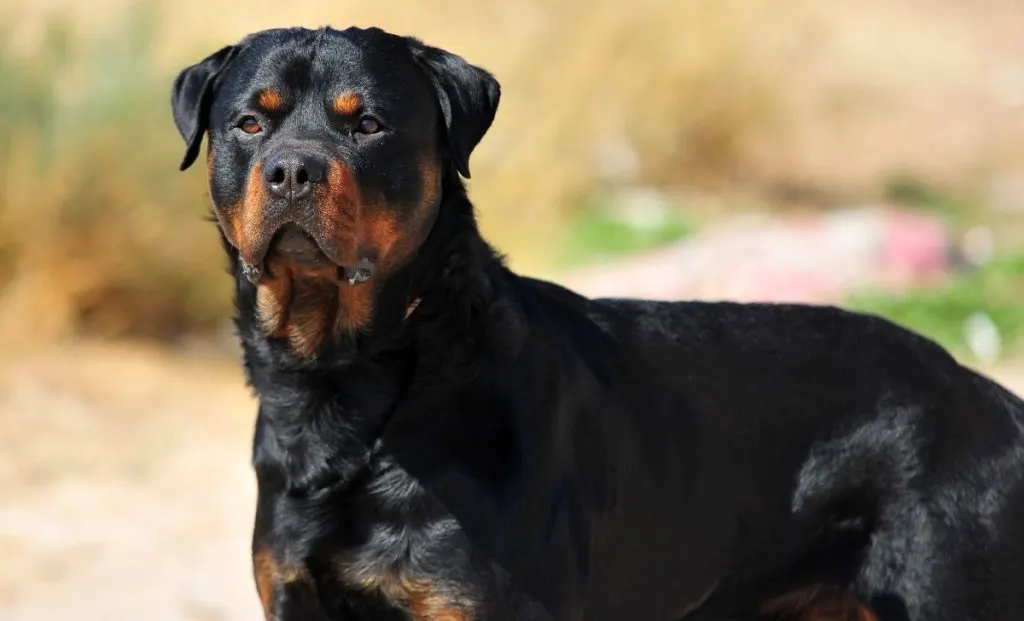
This is the standard Rottweiler we all know and love.
Black and mahogany Rotts have a black base coat and deep red markings that vary in shade from cognac color and mahogany to dark brown.
These markings cover the Rottweiler dog’s muzzle, chest, and parts of his front and hind legs. Mahogany markings will also be above the dog’s eyes and on two spots on its cheeks.
At first glance, these markings might resemble one of the most standard Doberman colors, which is why some people tend to confuse the two dog breeds.
While there are some minor differences in color distribution, the main difference between the two dogs is in their build and breed history.
Rottweilers were built for dog sports and guard duties, so they are thick, strong, and large. They have floppy ears and short muzzles, which is why some people mistakenly think of them as brachycephalic dogs.
On the other hand, Dobermans were built to be tax collector dogs. They have long, slim but muscular bodies, as well as elongated muzzle and cropped ears.
2. Black And Tan Rottweiler
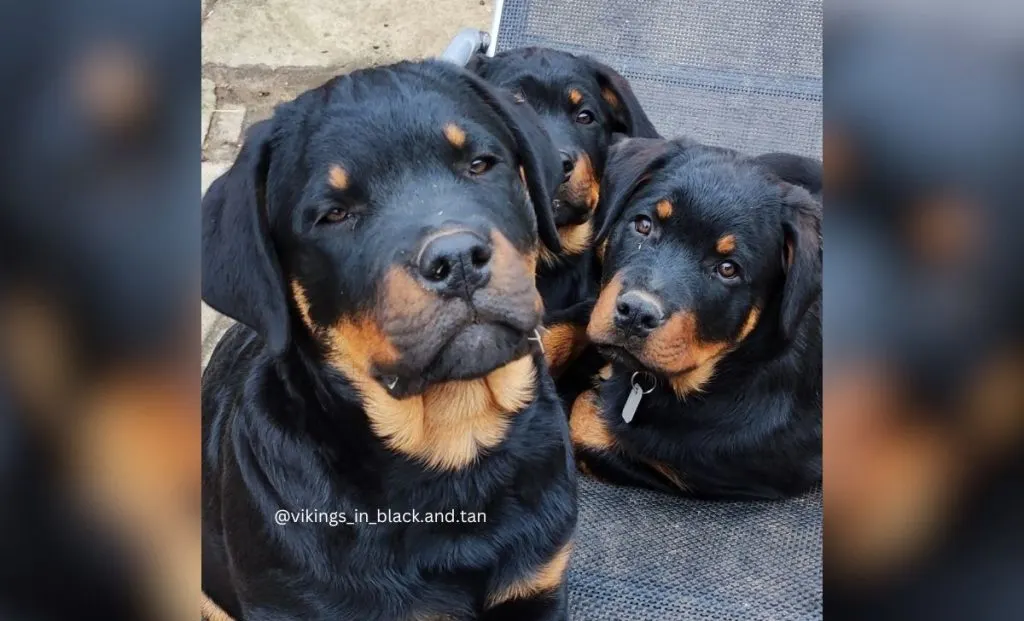
Black and tan Rottweilers look rather similar to the previous color I’ve mentioned, but they are lighter and cooler in shade.
This color is more common in Doberman Pinschers, but it’s also allowed in Rottweilers.
The tan markings can vary in shade from light brown to golden. They pose a great contrast to the black base coat, giving your dog a striking look.
Just like in black and mahogany dogs, mahogany markings can be found on the dog’s chest, paws, front and rear legs, muzzle, and eyebrows.
These are the lightest markings that are allowed in the Rottweiler breed.
UKC and FCI only allow black and tan dogs within their standard. However, you might be able to register black and mahogany and black and rust dogs as black and tan dogs, even though their exact shade would most likely be considered faulty.
3. Black And Rust Rottweiler
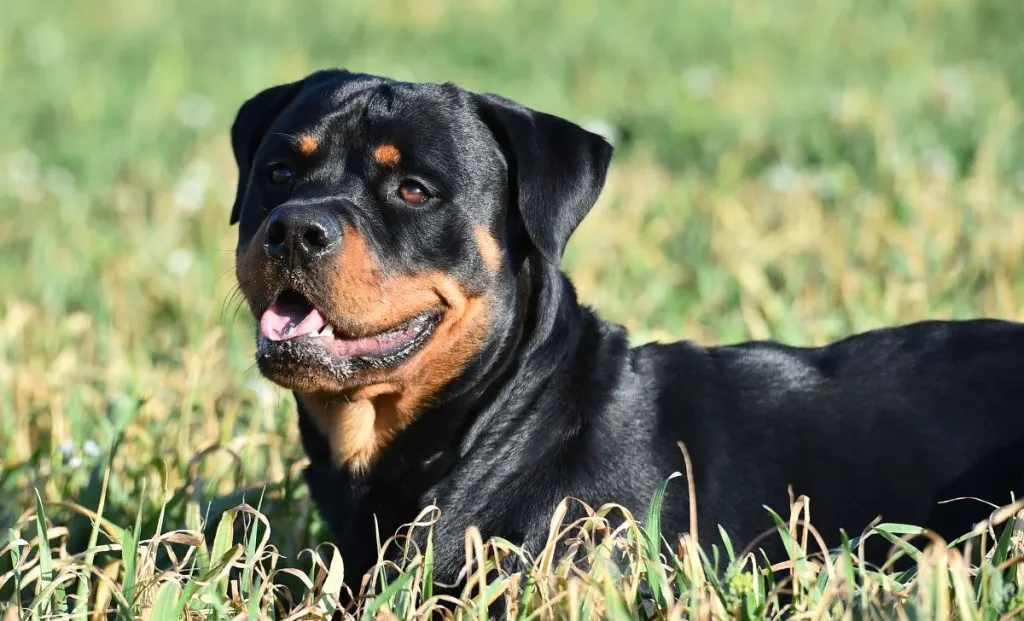
The last standard and recognized coat color in Rottweilers is black and rust.
Rust is quite similar to mahogany. In fact, many pet parents and even experienced breeders struggle to see the difference between the two.
In fact, the only trait that sets the two apart is that rust is a slightly lighter and paler shade, while mahogany is more rich in color.
These pups have markings located in the same area as other bicolor dogs. This includes muzzle marks, eyebrow marks, and markings on the dog’s chest and legs.
Here’s a fun fact for you: Rottweilers and Affenpinschers are the only two dog breeds that are considered to have genuine rust-colored coats.
Isn’t that amazing?
Non-standard Coat Colors
As mentioned before, there are a few more Rottweiler colors that are not recognized by the AKC.
Non-standard but recognized colors usually mean that the dog cannot participate in conformation shows, as it is considered faulty and not according to the breed standard.
However, they aren’t an indication that the dog is not purebred or that there’s anything wrong with him.
On the other hand, if a dog comes in a color that isn’t even recognized, this is a huge red flag as it could mean that the dog is struggling with some genetic conditions or that it is a mixed breed.
Not a single one of the non-standard coat colors in Rottweilers isn’t recognized, which means they are absolutely not allowed in the breed. Still, you might find some dogs that come in these specific shades.
I’ll explain what this means for each color in question.
Here’s what some of the non-standard Rottweiler colors are:
1. Black Rottweiler
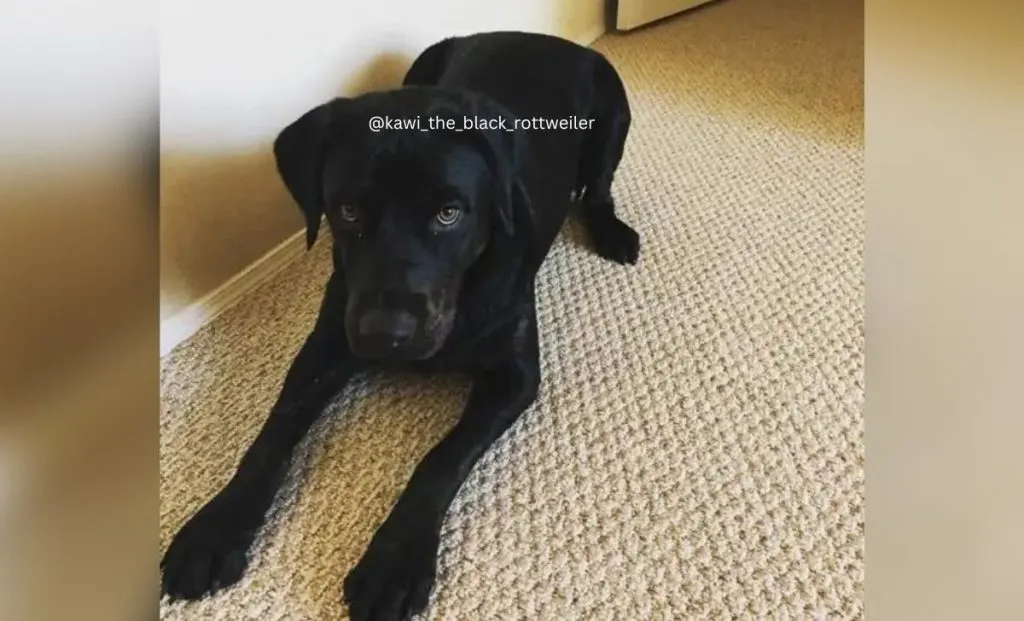
Solid black is quite a rare color in most breeds of dogs, and this includes the Rottweilers.
These pups have a black coat without the specific markings that are typical for the Rottweiler breed.
Others have markings that are so dark that the pup might appear pure black at first glance.
Almost all purebred Rottweilers carry a specific gene that is responsible for the markings you see on these dogs. If a Rottweiler comes in a solid black color, then it is most likely crossbred – typically with a black Labrador Retriever or a Cane Corso.
In other words, you might be looking at one of many Cane Corso mixes and not at the purebred Rottie you are hoping to get!
This is why it’s important to only purchase from reputable breeders that are selling dogs from good bloodlines.
2. Red Rottweiler
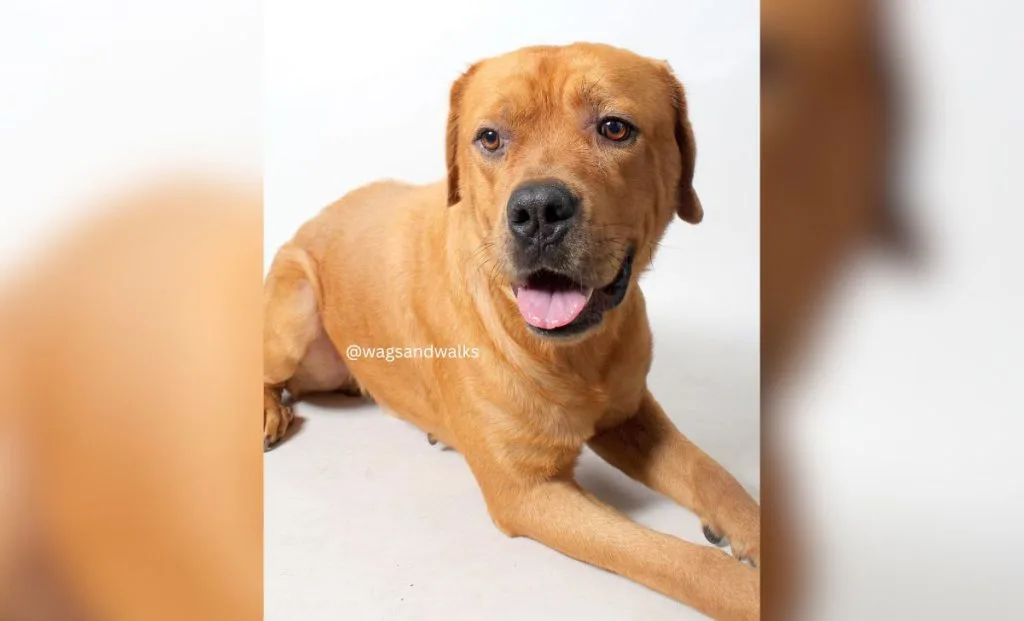
Red Rottweilers have a mahogany or chocolate coat color that is rather unique. Due to their shade, many people consider them to be overgrown Labrador Retrievers.
Some of these pups have standard Rottweiler markings that are a few shades lighter than the base coat. Others come in a single solid color.
While beautiful, this coat style can rarely be found in purebred Rotties. This means that most red Rottweilers are crossbreeds, just like their black counterparts. However, it is possible for a Rottweiler to be born in a deep tan hue.
This Rottweiler color is the result of recessive genes. It can spontaneously appear from two regular Rottweiler parents.
The earliest records of red Rottweilers can be found since the breed was first recorded in ancient Rome. This proves that the color was always there.
The color gained huge popularity in the late 19th century, together with its black and tan counterparts. Rottweilers were always loved for their traditional work, police work, and guard dog duties.
Despite this, almost no kennel club recognizes red Rottweilers. This also means that no reputable breeder will intentionally breed red Rottweiler puppies.
If you see a breeder advertising Rotties with solid red or rust coats and claiming that these puppies are their specialty, keep in mind that the person you are talking to is likely conducting unethical breeding practices.
Of course, this isn’t always the case. As mentioned, sometimes red can spontaneously appear in this breed, and two standard Rotties can produce a red Rottweiler.
Due to their unique rarity, red Rottweilers can have a high price range. Considering the popular opinion that they’re the most beautiful Rottweiler variety, this shouldn’t be a surprise.
3. Blue Rottweiler
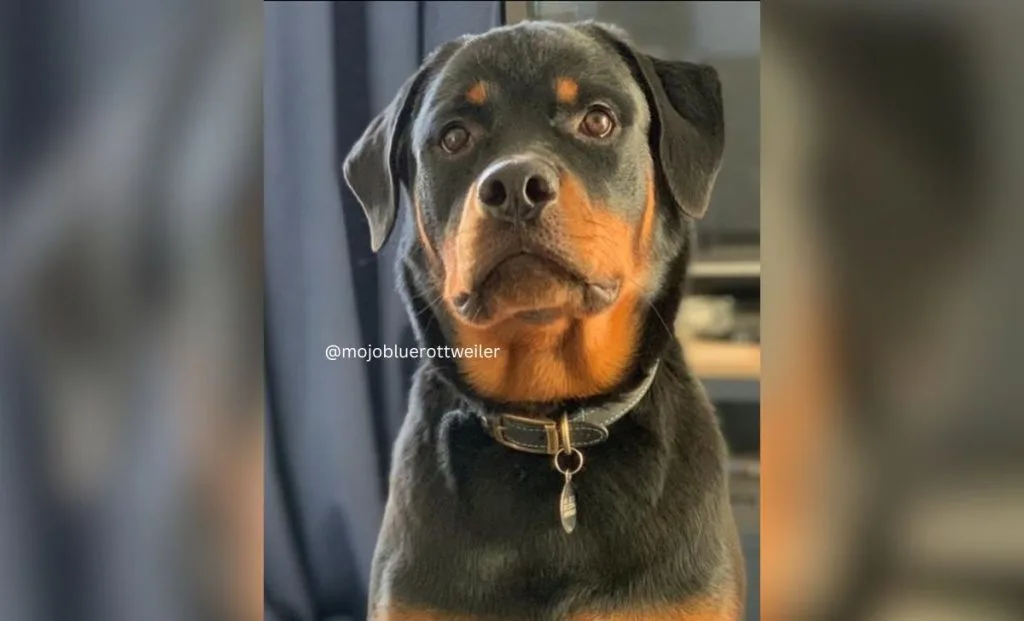
Blue is a pretty rare color in the Rottweiler breed – although not as rare as red or solid black.
As in most other breeds, the blue color is the result of a specific blue dilution gene. This gene turns all the black pigment into a shade that can vary from gunpowder gray to dark silver.
This means that most blue Rottweilers have mahogany, rust, or tan markings on their bodies. Some might be solid blue, but as mentioned before, most of these pups are mutts and not purebred Rottweilers.
Blue color can occur naturally in this breed. However, it is connected with a few Rottweiler health issues – most notably, color dilution alopecia (CDA). This is one of the reasons why it isn’t recognized by most kennel clubs, including the AKC.
4. White Rottweiler
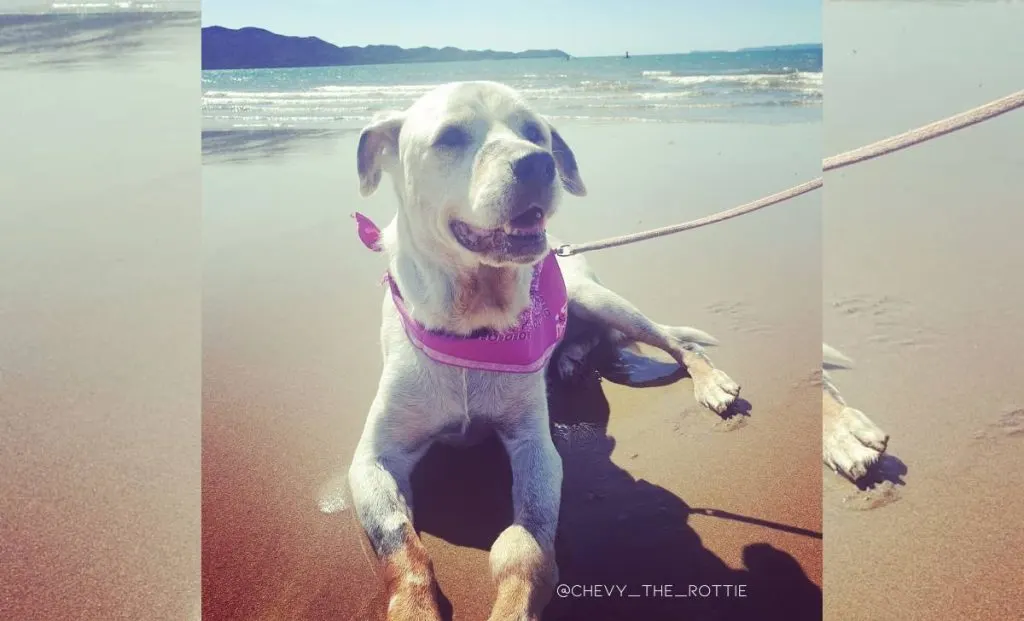
Finally, you have a white Rottweiler. This super rare dog is not allowed by any kennel club, and having a white coat is considered a major fault.
In most Rottweilers, the white color is the result of some health condition, such as canine vitiligo or albinism.
Canine vitiligo is a condition in which parts of the dog’s body lose pigment. This can result in white patches on the coat and skin.
Most dogs are not born with vitiligo but rather develop it at a certain point in their life. Vitiligo can spread, so you might notice your dog turning more white throughout time.
Albinism, on the other hand, is a genetic condition that results in total loss of pigment. This means that a pup is born with white fur, a pink nose, and blue or even red eyes.
The only other way in which a Rottweiler can come in a white coat is to be mixed breed with another large or medium-sized dog, such as a Dogo Argentino.
Coat Types
Not only are there several Rottweiler colors most dog parents don’t know about, but there are two coat types this magnificent breed can come in.
All of the shades and color combinations I’ve mentioned can come in both coat lengths. However, most kennel clubs allow only one fur type.
Here’s what they are:
Short-haired Rottweiler
According to the breed standard, Rottweilers should have a short double coat that will allow you to see their large average size, muscular bodies, strong tail tone, and thick legs.
The undercoat should be the thickest on the dog’s neck and thighs, and, next to the coat color, this is the important factor if you plan on participating in various conformation shows.
Due to their double coats, short-haired Rotties tend to shed a lot – even more than their long-haired counterparts.
Long-haired Rottweiler
Have you ever seen a long-haired Rottweiler? These adorable doggies do exist, and yes, most of the time, they are purebred!
Long-haired Rotties have a medium to long double coat, and if they are purebred, they will also have a thick undercoat.
A few of these fabulous pups are mixed breed, possibly with long-haired German Shepherds, so this is something you should be wary of.
One of the good ways to find out whether a long-haired Rottweiler is purebred is to check for the undercoat. Long-haired GSDs don’t have an undercoat, so most Rottweiler long-haired GSD mixes won’t have it, as well.
Long-haired Rottweilers are not up to the breed standard, so you’ll rarely find them on sale.
What Is The Rarest Color Of Rottweiler?
While standard Rottweiler colors are pretty common, the non-standard ones are more rare.
In fact, all of the unaccepted colors are quite rare! From solid black to white Rottweilers, you certainly won’t see them every day!
Still, while these colors are extremely sought after and expensive, I would advise you to think twice before purchasing them. There is usually a reason why a color is rare, and you might find out in the harder way.
Does Color Really Matter?
One thing is certain: All Rottweiler colors are equally beautiful! But are all equally good for the breed and the dog?
If a dog comes in a color that isn’t recognized by major kennel clubs, there is a high chance that a dog has been crossbred. This can affect the pup’s temperament and health, and you might get yourself into something you’re not ready for.
This is especially risky when dealing with protective dogs such as Rottweilers. You need to know you have all the right training information so your dog can be on its best behavior all the time.
Health issues connected with certain coat colors also pose a risk most people are not ready to take.
Because of this, I would always recommend everyone to stick to the colors that have been approved by the experts.
In the end, all Rottweilers can make amazing family pets and guard dogs if you’ve trained and socialized them on time. On its own, color doesn’t affect this.
So, as long as you’re wary of the dangers of buying a dog that isn’t according to the breed standard, you should pick a dog that suits your needs and aesthetics.
Good luck!
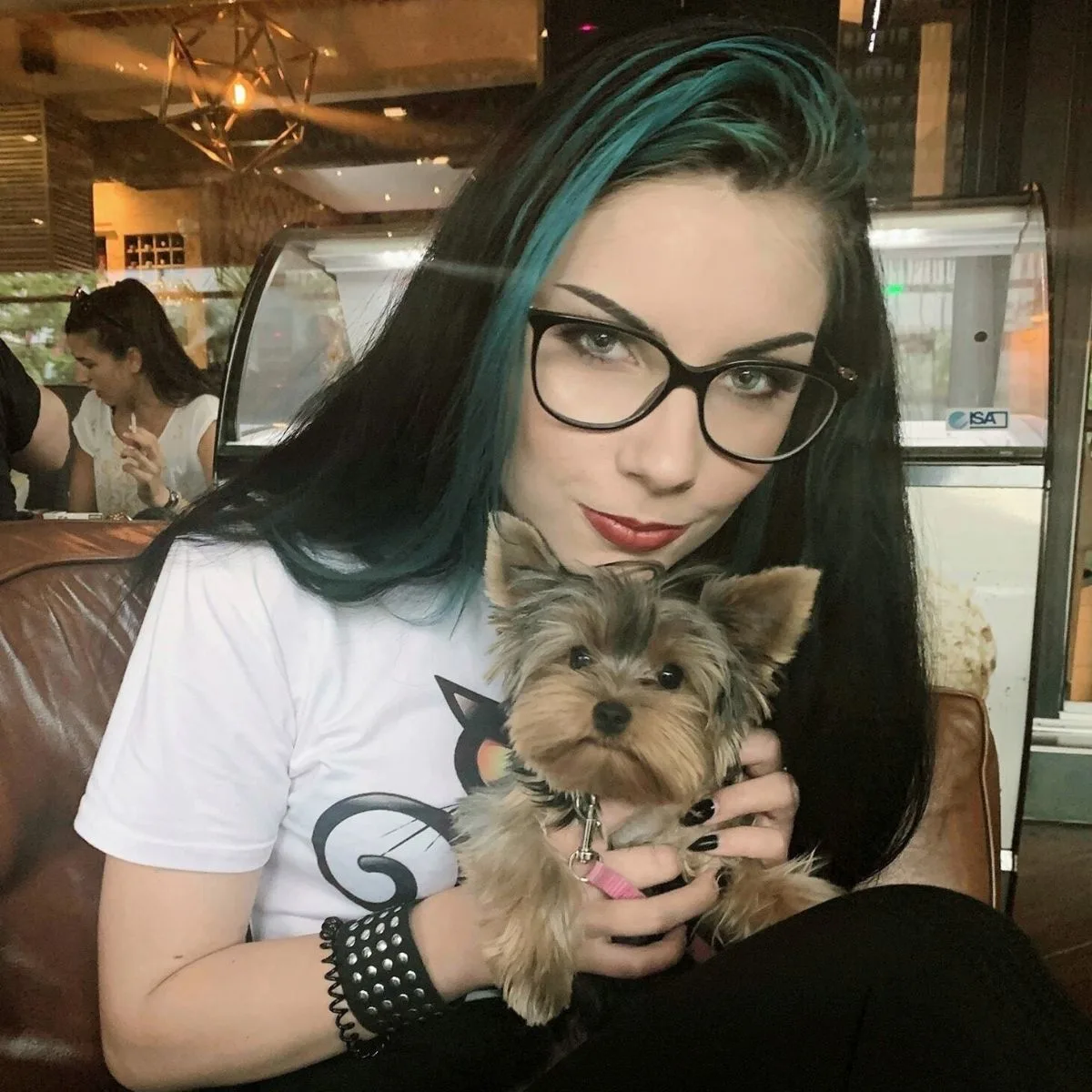
Vanja’s passion for writing started at an early age, which is why she pursued Journalism as her college degree. She can research any topic and find all the information before you bat an eye, which is a great thing for her job but a terrible one for her husband.
Even as a young child, she fell in love with everything fluffy – but dogs have a special place in her heart due to her childhood companion, a Corgie named Archie.
Motivated by her experiences and driven by a desire to give back to her four-legged companions, she spends her free time volunteering at a local dog shelter.
